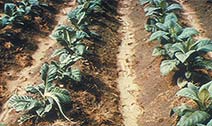Boron Deficiency in Tobacco

The characteristic symptoms of boron deficiency are short internodes and dieback of the apical meristem. The first sign is the development of a basal chlorosis on the youngest leaves. When the whole leaf is not affected, the leaves subsequently expand but become distorted. The leaves are often one-sided and twisted. Likewise, the stem near the top of the plant is often twisted.
After the death of the apical growing point, suckers are likely to develop but these are also prone to dieback. The leaves become stiff and brittle as they mature and as a result, the midribs frequently break.
When the deficiency does not become acute until the flowering stage, many flowering buds are shed and very few seed pods set.
Soil Application (Suggested rates of application)
| |
Granubor |
Fertibor |
| LBS/ACRE |
2-6 |
2-6 |
| KG/HA |
2.25 - 6.75 |
2.25 - 6.75 |
Foliar Application (Suggested rates of application)
| |
Solubor |
| LBS/ACRE |
1-4 |
| KG/HA |
1.125 - 4.5 |